So, how do you measure the effect on your blood sugar and how much sugar is TOO MUCH?
If you want to be accurate about it, it is the ‘glycemic load’ or GL of what you eat that counts. The GL is a calculation that factors in both the amount of carbs (QUANTITY) in a food and how fast that carb raises your blood sugar level, which is the GI (QUALITY). GL is by far the best measure because it also predicts how much insulinInsulin is a hormone made by the pancreas. It is responsible for making the body’s cells absorb glucose (sugar) from the blood…. you’ll release, and keeping insulin down is a fundamental key to good health.
To some degree you can get these two figures – quantity of carb and quality – from the label of a food. Have a look at the label below, for Nairns rough oatcakes. What you’ll see is that one oatcake delivers 6.2g of carbs, but only 0.1g is sugar.
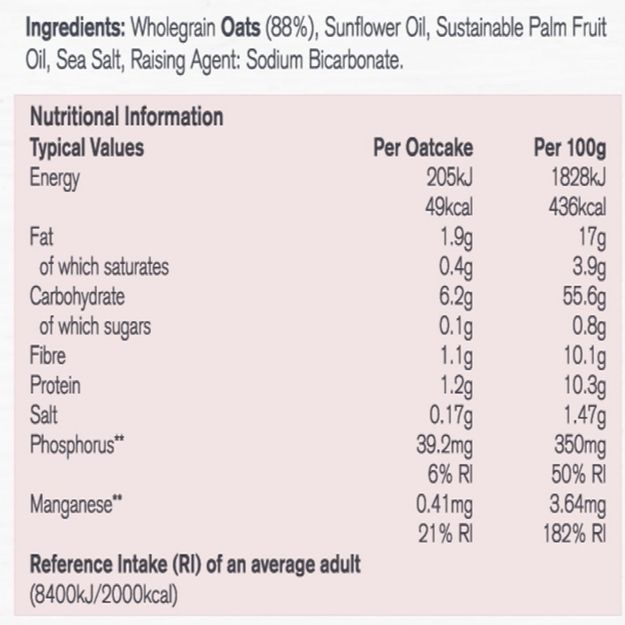
Now, a teaspoon of sugar is 4.2 grams in weight, so there’s very little actual sugar. So, there’s a bit more than a teaspoon of carbs, of which a tiny fraction is fast-releasing sugar.
The non-sugar carbs will raise your blood sugar, but not so much. You know by how much from the GL. This oatcake actually has a GL of 2. (You can see the GL of foods in my free online GL counter. You don’t want a snack with more than 5 GLs, if you’re trying to lose weight, or 6 GLs if you’re not. So, three oatcakes with something made of fatThere are many different types of fats; polyunsaturated, monounsaturated, hydrogenated, saturated and trans fat. The body requires good fats (polyunsaturated and monounsaturated) in order to… and/or proteinProteins are large molecules consisting of chains of amino acids. Proteins are essential nutrients for the human body – they are a building block of…, such as hummus, taramasalata, smoked salmon or peanut butter (no added sugar) would be OK.
So what are the sweetener options?
Let’s use this 5 or 6 GLs, which is about the equivalent of two teaspoons of actual white sugar, as our cut off point. To make this more real fructoseFructose is a simple sugar that occurs naturally in fruits, vegetables and their juices, as well as in honey…., that is fruit sugar, takes time to be converted in the liver to glucose, and this slows down its release. But once you’ve overloaded the liver’s ability to convert it it’s a really bad sugar. That happens above 6 teaspoons spread out over a day. So watch out for foods sweetened with fructose, and also dates, grape juice concentrate or raisins, which are high sugar foods. So are bananas. One banana has the equivalent of 6 teaspoons of sugar, so that’s you’re allowance for the day!
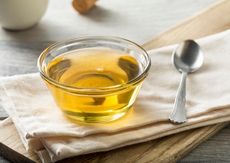
A teaspoon of sugar is about 2.7 GLs. This would apply to honey too. Agave is better. A tablespoon of agave is equivalent to a teaspoon of honey. The best of all is xylitolXylitol is a completely natural sweetener that looks and tastes like sugar. It is naturally occurring in many fruits and vegetables…., the crystallised version of xylose, which is the main sugar found in berries. Three tablespoons has the same GL as one teaspoon of sugar. So, if you feel you need to sprinkle a little on your cereal, or in a dessert or cake, that’s OK. Xylitol is a ‘sugar alcohol’, as is erythritol. They are both very low GL. The only caution is that too much can give you lose bowels. So don’t have too much. The other warning is that dogs can’t process sugar alcohols so xylitol is dangerous for dogs. Don’t feed your dog anything with xylitol.
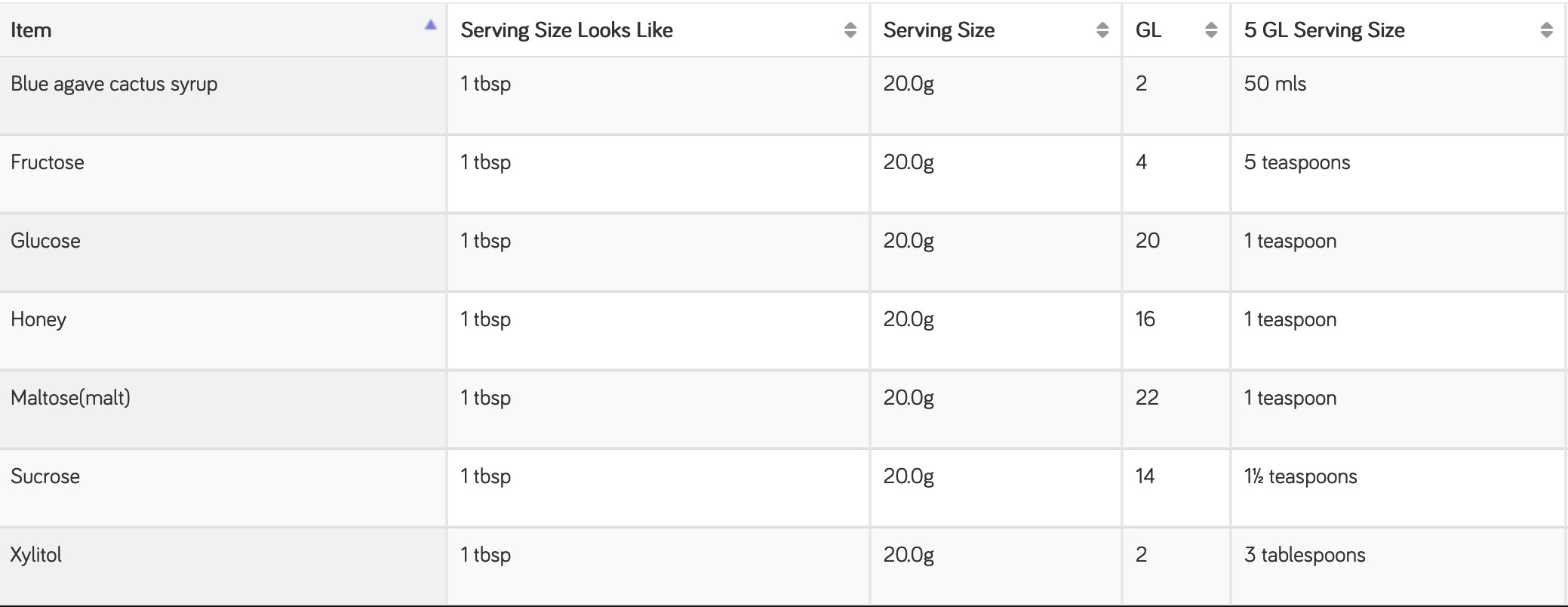
Most honey is heat treated, which makes the sugars faster releasing, so if you can get local unheated honey, spun by the bee keeper, it’s a bit better.
There are also two non sugars not shown on this list that don’t have a GL at all – stevia and inulin, which is from chicory root. These are fine. I use inulin in my Get Up & Go breakfast shake formula so you don’t have to add it. That, plus a handful of berries, is sweet enough. Stevia is OK but it has a strange taste, not to many people’s liking.
A Spoonful of Sugar….often much more
Dr David Unwin, who has been spearheading a campaign to get doctors to encourage low GL eating, has found a terrific way to illustrate GL for his diabetic and overweight patients. Instead of trying to explain the concept, he simply shows them the ‘teaspoons of sugar equivalent’ for each food, as indicated in the table below.

Adapted, with permission, from David Unwin’s charts in the Journal of Insulin Resistance (2016)
The GI column relates to how quickly or slowly each of these foods releases its sugar. For instance, the GI for strawberries is a relatively low 40 per cent (compared to 100 per cent for glucose). In addition, they have an extremely low glycaemic load (just 1 GL), which means that a typical (quite large) 120g portion provides the equivalent of less than half a teaspoon of white sugar. By contrast, while an apple’s GI is slightly lower, at 39 per cent, it contains more actual carbs so it has a much higher glycaemic load (6 GL) and therefore it raises blood sugar levels six times as much as the same quantity of strawberries. The last column converts the GL score into the equivalent number of teaspoons of (white) sugar. So, for example, a 120g apple would have the same blood sugar effect of 2.2 teaspoons of sugar.
That’s about as much as you want in a snack. 2.2 teaspoons of sugar equals 9.2g of sugar. So, if you look at the label of even a so-called ‘health food bar’ and its clocking up let’s say 8+g of sugar that’s about the maximum you want to eat in a snack, and not every day.
My rules of thumbs
- Avoid foods sweetened with sugar, dates or raisins, unless they are low down on the list of ingredients. Stevia, inulin, xylitol or erythritol as an added sweetener, is OK.
- Don’t eat foods clocking up much more than 5g of sugars a serving, and even then only as a treat
- Sweeten things that need sweetening with berries or fruit.
- Then, if more sweetener is needed drizzle a tiny amount of agave syrup, or possibly raw honey, as in my low GL oat pancakes
- If you’re making a cake use xylitol.
So what to do when you have sugar cravings and need a sweet fix?
Desserts
One of my favourite ‘fast’ desserts is a 5 minute crumble. I take the fruit – either berries or plums, and get them stewing in a little bit of water and a teaspoon of either CherryActive or BlueberryActive. Meanwhile ‘roast’ oats, with some nuts such as pecan pieces, in some coconut butter, add in some xylitol and keep stirring. Then put the fruit in a bowl and add on the crumble top. You make a delicious cashew cream with cashews and water. That’s about 11GLs. You don’t want to do this everyday but, as a treat now and again, that’s fine. (The GL allowance for weight loss is 10 GLs for a main meal and 5 GLs for a drink or dessert.) Multiply up these quantities if there’s four people.

Cakes
My favourite cake is Carrot and Walnut Cake as a tea-time treat that you can enjoy without feeling guilty. The walnuts, carrots and eggs in this cake lower the GL score and provide plenty of varied nutrients. Delicious with a cup of peppermint tea at the end of a long day. This comes from my Low GL Diet Cookbook which has lots of other delicious cakes and desserts.
If you’re using the walnut topping, this cake will keep in an airtight tin for up to 2 days. If you opt for the cream cheese frosting, cover the cake and store in the fridge for the same amount of time.
You could also double or triple the recipe and then cut into 5GL slices and freeze – so you have a regular supply. Handy for taking to work for your mid afternoon snack.
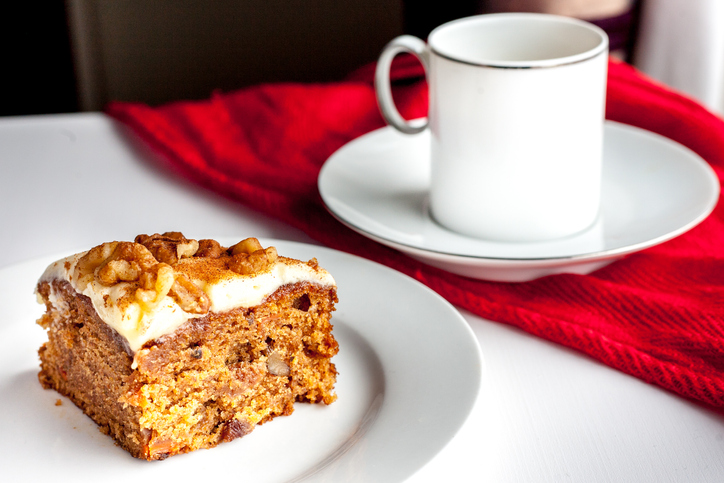
Serves 4
For the cake
50g (2oz) coconut oil or butter (at room temperature)
50g (2oz) xylitol
50g (2oz) organic soya flour (available from health food stores)
½ tsp baking powder
50g (2oz) ground walnuts
50g (2oz) chopped walnuts
1 medium carrot (approximately 75g/3oz) peeled and finely grated
2 medium eggs
For the topping
either
Walnut topping
2 tbsp chopped walnuts
or
Cream cheese frosting
50g (2oz) low fat cream cheese
¼ tsp vanilla extract
1 tsp xylitol
- Preheat the oven to 180C/350F/Gas mark 4. Grease and line a miniature 10cm/4” cake tin with non-stick paper.
- Cream the coconut oil or butter and xylitol together until soft and smooth.
- Stir in the flour, baking powder and ground walnuts until the mixture resembles bread crumbs.
- Mix in the chopped walnuts and carrot, then stir in the eggs without beating them.
- Spoon into the prepared cake tin and sprinkle the chopped walnuts on top if using. Bake for 35 minutes or until the top is risen and golden. Remove from the oven and cover the top with tin foil, then bake for a further 20 minutes or until the cake is cooked (Tip: insert a skewer into the middle – if it comes out fairly clean then the cake is cooked, if it is still runny then it needs a bit longer). Allow to cool before icing with the cream cheese frosting, if using.
- 6 To make the cream cheese frosting, mix all the frosting ingredients together well. Spread on top of the cooled cake.
GLs per serving: 5
Supplement Support
If you need further support to keep your blood sugar balanced, check out the Patrick Holford MetabolismMetabolism is a term that is used to describe the chemical reactions that take place within the body’s cells. The body gets the energy it… range which was formulated for this purpose:
Low GL Diet and Diabetes Support Combo – A combo for anyone who needs support with weight loss or a diabetes reversal programme.
Cinnachrome – it contains chromiumWhat it does: Helps balance blood sugar, normalise hunger and reduce cravings, improves lifespan, helps protect cells, essential for heart function. Deficiency Signs: Excessive or… which helps maintain blood sugar levels, providing a stable source of fuel for the body, and assists in reducing sugar cravings. It works in synergy with cinnamon and Niacin.
Carboslow Powder – contains glucomannan, derived from Konjac Root. It fills the stomach, making you feel full. Great if you’re on a weight loss programme.
Get Up and Go
A nutritious start to the day as a healthy shake/smoothie giving you essential vitamins and minerals with fibreFibre is an important part of a balanced diet. There are two type of fibre; soluble and insoluble. Insoluble fibre helps your bowel to pass…, protein and essential fatty acidsEssential Fatty Acids (EFAs) are fats that must be taken in through the diet as they cannot be made by the body. Both omega-3 and… from almonds, flax, sunflower, sesame and pumpkin seeds, oat bran, quinoa, rice, soya and white beetroot. The shake is flavoured with organic apples and naturally sweetened with prebiotic FOS, which provides food for friendly bacteria.
Provides nutrients such as B vitamins, biotinWhat it does: Particularly important in childhood. Helps your body use essential fats, assisting in promoting healthy skin, hair and nerves. Deficiency Signs: Dry skin,…, calciumWhat it does: Promotes a healthy heart, clots blood, promotes healthy nerves, contracts muscles, improves skin, bone and dental health, relieves aching muscles and bones,…, ironWhat it does: As a component of red blood cells, iron transports oxygen and carbon dioxide to and from cells. Also vital for energy production…., magnesiumWhat it does: Strengthens bones and teeth, promotes healthy muscles by helping them to relax, also important for PMS, important for heart muscles and nervous… and manganeseWhat it does: Helps to form healthy bones, cartilage, tissues and nerves, stabilises blood sugar, promotes healthy cells, essential for reproduction and red blood cell… which contribute to normal energy-yielding metabolism and 939mg vitamin CWhat it does: Strengthens immune system – fights infections. Makes collagen, keeping bones, skin and joints firm and strong. Antioxidant, detoxifying pollutants and protecting against… and 15mg of zincWhat it does: Component of over 200 enzymes in the body, essential for growth, important for healing, controls hormones, aids ability to cope with stress…. Also chromium to assist with normal blood glucose levels. This new formula contains super soluble glucomannan fibre to help you feel full and promote weight-loss as part of a calorie-controlled diet.
Blend 30g daily with half a pint of milk, soya milk or rice milk, oat or nut drink, a handful of berries. If you blend with a carb free almond milk and 60g of berries it provides only 4.5GLs per adult shake. Perfect for those following The Low GL Diet or The 5 Day Diet.
GL Support
GL Support may be particularly useful for those following a diet or exercise plan as it combines three supporting nutrients- Garcina Cambogia Fruit, Chromium and L-Carnitine. Chromium contributes to normal nutrient metabolism and to the maintenance of normal blood glucose levels.
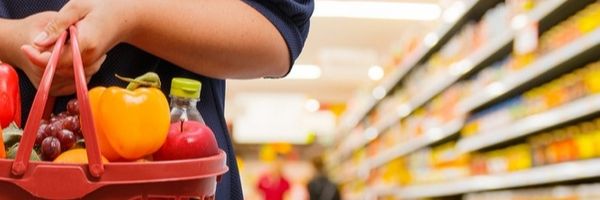

Comments
Join the Conversation on our Facebook Page